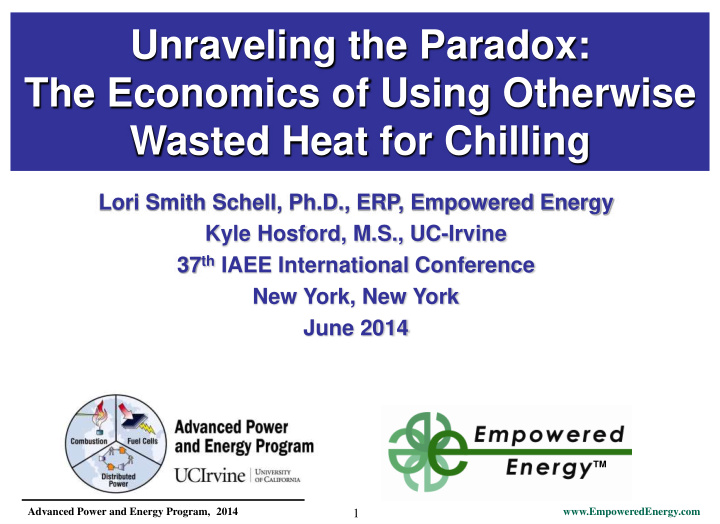



Unraveling the Paradox: The Economics of Using Otherwise Wasted Heat for Chilling Lori Smith Schell, Ph.D., ERP, Empowered Energy Kyle Hosford, M.S., UC-Irvine 37 th IAEE International Conference New York, New York June 2014 TM Advanced Power and Energy Program, 2014 www.EmpoweredEnergy.com 1
Motivation • Air conditioning in commercial buildings accounts for 16% of California’s electricity consumption • Estimated to grow at 1.30% p.a. through 2024 • Dominant technology: Electric Chillers, which contribute to peak electricity consumption • A high- temperature fuel cell (“HTFC”) generates significant amounts of high quality exhaust heat • Exhaust heat is wasted in electricity-only fuel cell operations • If captured, otherwise-wasted exhaust heat can be fed to an absorption chiller for air conditioning. Advanced Power and Energy Program, 2014 www.EmpoweredEnergy.com 2
Piping & Instrumentation Diagram Advanced Power and Energy Program, 2014 www.EmpoweredEnergy.com 3
Absorption Chiller: How It Works Advanced Power and Energy Program, 2014 www.EmpoweredEnergy.com 4
HTFC/Chiller Model: Major Components (1) User Interface to specify building type and select equipment (2) Equipment dispatch to meet building load (3) Levelized Cost of Energy (“LCOE”) calculations based on equipment dispatch Advanced Power and Energy Program, 2014 www.EmpoweredEnergy.com 5
HTFC/Chiller Model: User-Friendly Interface Advanced Power and Energy Program, 2014 www.EmpoweredEnergy.com 6
HTFC/Chiller Model: Cost Module Advanced Power and Energy Program, 2014 www.EmpoweredEnergy.com 7
LCOE Changes with Size & Building Load • Optimal fuel cell size depends on availability of complementary technologies • Higher capacity, lower capacity factor • Lower capacity factor, higher LCOE • Thermal energy storage (“TES”) and/or natural gas-fired boiler allow for smaller HTFC capacity and greater efficiencies • Must balance efficiencies vs. equipment costs • Model an existing building on UCI campus • Multipurpose Science & Technology Building (“MSTB”) • All physical flows converted to MW or MWh electric or thermal, as appropriate Advanced Power and Energy Program, 2014 www.EmpoweredEnergy.com 8
MSTB: Traditional Cooling/Heating Advanced Power and Energy Program, 2014 www.EmpoweredEnergy.com 9
MSTB: 300 kW FC + Abs Chiller + Boiler Advanced Power and Energy Program, 2014 www.EmpoweredEnergy.com 10
MSTB: Add Electric Chiller for Backup Advanced Power and Energy Program, 2014 www.EmpoweredEnergy.com 11
MSTB: TES Instead of Electric Chiller Advanced Power and Energy Program, 2014 www.EmpoweredEnergy.com 12
Conclusions • A high-temperature fuel cell/absorption chiller unit effectively displaces traditional electric chillers • Peak and total electricity consumption is reduced • Value of peak reduction is not monetized • LCOE is reduced vs. the traditional technology • $119.80/MWh vs. $120.54/MWh • Backup equipment increases LCOE & reliability • Value of increased reliability is not monetized • Adding complementary technologies increases fuel cell sizing flexibility and operating efficiencies • Ongoing research • What is the potential market size in California? • What are the market entry barriers? Advanced Power and Energy Program, 2014 www.EmpoweredEnergy.com 13
Author Contact Details Lori Smith Schell, Ph.D., ERP Empowered Energy +1 (970) 247-8181 LSchell@EmpoweredEnergy.com Kyle Hosford, M.S. University of California-Irvine +1 (619) 672-0687 kshosford@gmail.com Advanced Power and Energy Program, 2014 www.EmpoweredEnergy.com 14
Recommend
More recommend